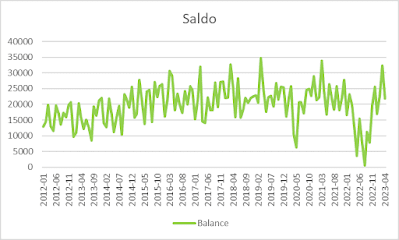The German balance of payments: an insight
(… the cap on tweets set by Elonio Muschio killed the views of the blog, which from one day to the next dropped by between 40% and 50%, despite the fact that the previous post attracted a lot of debate – for which I thank you: it helped me to understand many things. I point this out for the benefit of those who are passionate about battles and above all for symbolic "victories". Muschio is alive but, even if it is not toxic like Barbetta, it does not fight together, but against us, it's definitely not a piece of the solution, but of the problem: better that we remember! updated on what comes out here, I advise you to subscribe. I take up in detail a topic that emerged in a previous post: why has the German surplus exploded again? The topic is important because the German surplus, as we know, is the engine of the global macroeconomic imbalances, and therefore of the reaction to them …)
Very quickly: This is the current account balance of the German balance of payments:
(monthly data, millions of euros at current prices) where the dip of May 2020 is very good, and then the even worse one of August 2022. The balance is the difference between exports (money entering for goods leaving) and imports (money out for goods in), so it may be useful to combine this graph with that of its two components:
from which we infer that the dip in May 2020 was due to the collapse of world trade due to the lockdown, and that that of August 2022 was due to an explosion in imports due to the increase in fuel prices. It remains to be seen how the quo ante surplus levels were regained. The terminal part of the graph seems to indicate a relative stagnation of exports, combined with a collapse of imports (determined by the return of the prices of raw materials and energy sources, and perhaps also by the recession).
If we zoom in on the last few months we actually see this:
However, if we analyze the long-term export trend, extrapolating the historical trend from January 2012 to December 2019 to date, we see this:
So yes, the surplus has recently exploded (or rather imploded before) because the cost of imports had soared, but exports have also contributed with faster growth than their historical trend. However, it should be remembered that the balance of payments data are in value, and therefore also the deviation of exports towards the other could be due to an increase in the prices of exported goods.
As a counter-evidence, we can use national accounts statistics, which give us the exports and imports of goods and services (a major component of the current account balance) in real terms (in this case, quarterly data at 2010 prices):
Put like this (the data are quarterly, there is no monthly national accounts) the phenomenon takes on another dimension. In real terms, i.e. in terms of volumes, of pieces actually produced, after the plunge in 2020 German exports have shifted up a couple of gears, and the recovery of the balance in the last two or three quarters does not appear to be due to a particularly lively trend in exports (which therefore in the previous graph we can assume depended on inflation) as much as on the drop in imports. Nota bene: if examined at current prices, the dip in 2020 appears higher than that of 2022, and it fits: in 2020 the world production chains were blocked, therefore the volumes of exports and imports had decreased (the former more than the latter ), while in 2022 import prices simply increased. In real terms, the lockdown had a more evident and heavy impact on German trade (and many other countries) than the energy crisis.
This explains why my friends in Brussels tell me that their German colleagues are quite concerned (understatement) by their country's incipient deindustrialisation. Maybe they exaggerate (because it suits them: in this way they can ask for preferential treatment), but there is something similar in the data.
Good night!
This is a machine translation of a post (in Italian) written by Alberto Bagnai and published on Goofynomics at the URL https://goofynomics.blogspot.com/2023/07/la-bilancia-dei-pagamenti-tedesca-un.html on Sun, 02 Jul 2023 20:27:00 +0000. Some rights reserved under CC BY-NC-ND 3.0 license.





